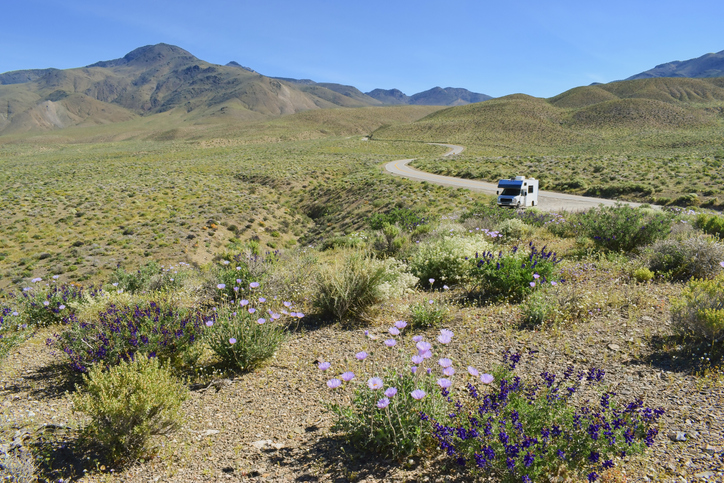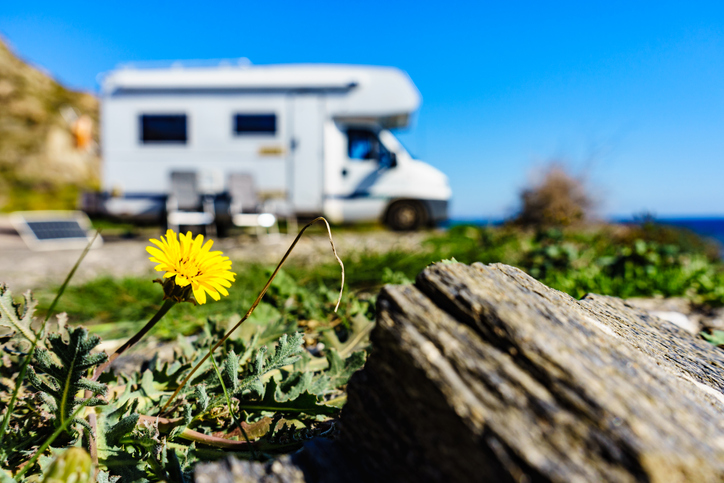We know some of our readers RV all year long, but others pack up their rig for winter. The leaves are turning green, the weather is getting warmer, and we’re seeing lots of rain and showers. We hope you’re as excited as we are – it’s springtime!
5 Ways to Get Your RV Ready for Spring
With the turn of the season comes a bit of responsibility if you have an RV. There are some steps that need to be taken in order to prepare your rig for spring and the adventures ahead. That’s why we’ve put together a list of five actions we think you need to take maintenance-wise so your motorhome is spring-ready!

Check your tire pressure and tread
During the winter months, your tires can lose around two to three psi of pressure each month. If you store your RV somewhere outside, or you’re in a really cold climate, your tires are probably even more deflated when it’s time to uncover it. Checking your tire pressure might be one of the most important steps you can take in ensuring a safe trip each time you travel.
Not only should you check the tire pressure, but now is a good time to check the tread on your tires. A general rule is to replace them once they reach about 6/32 tread depth.
Recharge and reinstall batteries.
Just as your tire loses pressure over time and in cooler weather, batteries lose a certain amount of their charge because of internal leakage. You can reduce the amount of charge they lose and extend their lifespan by charging them throughout the off-season, but it’s not a problem if you don’t! Just be sure to give them a good charge before the season starts.
You can check the charge by using a voltmeter, but make sure the battery isn’t connected to electricity. You’ll get a false reading this way. If any battery you check isn’t fully charged, allow it to do so. And, be sure you give yourself enough time between charging and when you plan to leave. Depending on the size, a full battery charge can take anywhere between a few hours and a few days.
Flush your entire water system.
You probably filled your pipes or holding tank with anti-freeze before the cold weather arrived, and the time has come to flush it out. You’ll want to drain the tank entirely and then add fresh water in to flush out the anti-freeze. Turn the water pump on and open all water faucets to let the water run through them for at least several minutes. Flush the toilet a time or two, as well. Once the water runs clear, you’re safe to turn the pump off and close all faucets.
You’ll also need to replace the water cartridges your removed during the winterizing process, and be sure to dump your gray and black tanks at an official dumping site.
Running water through the faucets for several minutes often completely dissolves the anti-freeze taste, but not always. Give it a small taste, and if you get any residual or lingering anti-freeze taste, baking soda will do the trick! A great all-purpose to even store in your RV to always have on hand, sprinkle a bit in each drain, and run the water again until it tastes clean.
Once you flush your water system, it’s a good idea to sanitize it, too. This will remove any mold or bacteria that built up over time. You can do this by creating a weak bleach and water mixture and flushing it through the water system.

Check all parts of your engine.
If you aren’t comfortable doing this yourself, (no shame in that) bring it to a trusted dealer in your area and have a technician complete a full maintenance check. This way, you’ll be confident your rig is performing at its best. If you’re a DIY kind of person, below is a shortlist of all the items and fluids to check. If any of these levels are low, top them off or bring it in to be serviced by us!
- Power steering fluid
- Oil level (it may be time for an oil change, as well)
- Windshield washer fluid
- Brake fluid
- Check that all lights are fully functional
After checking your fluids, hop in the driver’s seat and start the engine. Make sure all gauges, meters, and lights are working. This is a great time to check windshield wipers, too.
Restock your first aid kit and emergency materials.
This is yet another critical step in preparing your RV for spring but is often overlooked or simply forgotten. You might still have your first aid kit ready and available, from last season or even before, but are the medicines expired? Are there any bandages you’re running low on?
Go through your kitchen next and toss any dried food that expired over the winter, and restock on plenty of bottled water. You should also check your toolset and make sure you haven’t misplaced any basic tools you might need on the road.
We hope our list of things to do to your RV to prepare for spring helps you in having a wonderful camping season. As always, check us out on our website, or stop by and say hello to a friendly staff member today!


